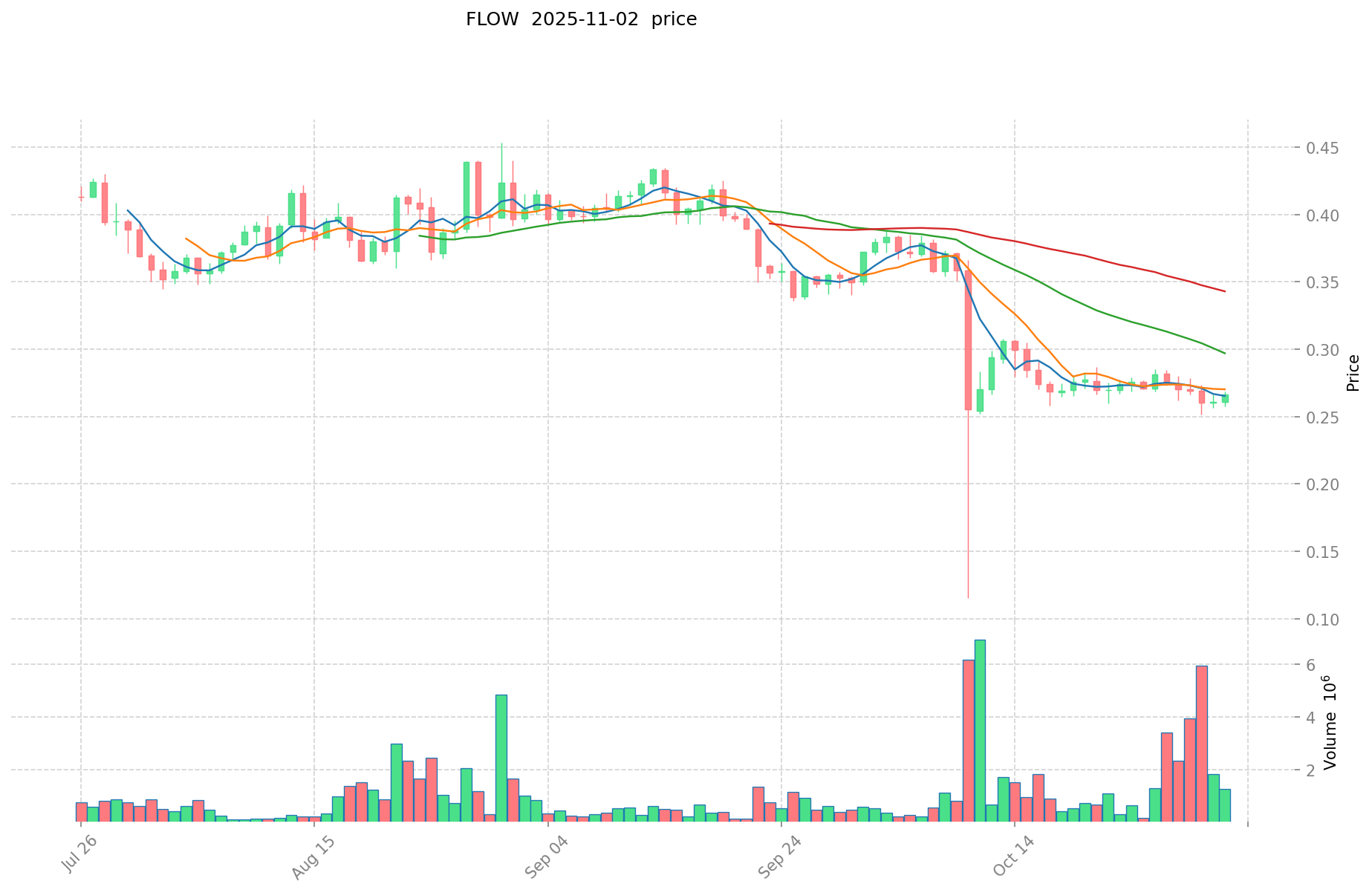BYN ile FLOW: Dijital varlıkların geleceğini belirleyen blockchain platformlarının rekabeti


Giriş: BYN ve FLOW Yatırımlarının Karşılaştırılması
Kripto para piyasasında BYN ile FLOW’un karşılaştırılması, yatırımcılar açısından daima gündemde olan bir konudur. Bu iki varlık, hem piyasa değeri sıralaması, hem kullanım alanları hem de fiyat performansı açısından önemli farklar sergilerken, kripto varlık ekosisteminde de farklı pozisyonları temsil etmektedir.
BYN (BYN): 2021’de piyasaya sürülen BYN, merkeziyetsiz sentetik finansal ürünlere odaklanması sayesinde piyasa tarafından tanınmıştır.
FLOW (FLOW): 2020’de tanıtıldığından bu yana, yeni nesil oyunlar ve uygulamalar için bir platform olarak öne çıkmış, küresel işlem hacmi ve piyasa değeri açısından başlıca kripto paralardan biri haline gelmiştir.
Bu makale; BYN ve FLOW’un yatırım değerini, tarihsel fiyat eğilimleri, arz mekanizmaları, kurumsal benimseme, teknolojik ekosistemler ve gelecek projeksiyonları üzerinden kapsamlı biçimde analiz edecek ve yatırımcıların en çok merak ettiği şu soruya yanıt arayacaktır:
"Şu anda hangisi daha avantajlı bir alım?"
I. Fiyat Geçmişi Karşılaştırması ve Güncel Piyasa Durumu
BYN ve FLOW Tarihsel Fiyat Hareketleri
- 2021: FLOW, 5 Nisan 2021’de tüm zamanların en yüksek seviyesi olan $42,40’a ulaştı.
- 2025: BYN, 9 Nisan 2025’te en düşük seviyesi olan $0,00034276’ya geriledi.
- Karşılaştırmalı analiz: Zirve noktalardan bu yana, BYN $5,14’ten $0,0009791’e, FLOW ise $42,4’ten $0,2707’ye düştü.
Güncel Piyasa Durumu (02 Kasım 2025)
- BYN güncel fiyat: $0,0009791
- FLOW güncel fiyat: $0,2707
- 24 saatlik işlem hacmi: $11.309,76 (BYN) ve $498.552,94 (FLOW)
- Piyasa Duyarlılığı Endeksi (Korku & Açgözlülük): 33 (Korku)
Gerçek zamanlı fiyatları incelemek için tıklayın:
- BYN güncel fiyatı için Piyasa Fiyatı
- FLOW güncel fiyatı için Piyasa Fiyatı


BYN ve FLOW’un Yatırım Değerini Etkileyen Faktörler
Arz Mekanizması Karşılaştırması (Tokenomik)
- FLOW: Arz mekanizması piyasa dinamiklerine bağlıdır, fiyat değişimleri yatırımcı güveniyle ilişkilidir.
- BYN: Belirgin arz mekanizması hakkında sınırlı bilgi mevcuttur.
- 📌 Tarihsel gözlem: Arz mekanizmaları, yatırımcı güveni dalgalanmaları ve düzenleyici gelişmeler ile fiyat döngüselliğini tetikler.
Kurumsal Benimseme ve Piyasa Kullanımı
- Kurumsal varlıklar: Piyasa duyarlılığı ve yatırımcı güveni, iki token’ın benimsenmesinde belirleyici etkendir.
- Kurumsal kullanım: FLOW’un USD karşısındaki değeri; makroekonomik gelişmeler başta olmak üzere çeşitli faktörlerden etkilenir.
- Düzenleme politikaları: Yasal düzenlemeler, FLOW’un farklı bölgelerdeki fiyat hareketlerinde temel rol oynar.
Teknolojik Gelişim ve Ekosistem Oluşumu
- FLOW teknik güncellemeleri: FLOW’un değerinde teknik inovasyon kritik öneme sahiptir.
- BYN teknik gelişimi: Spesifik bilgi kısıtlıdır.
- Ekosistem karşılaştırması: Her iki varlık da blokzincir teknolojisindeki genel gelişmelerden etkilenmektedir.
Makroekonomik Faktörler ve Piyasa Döngüleri
- Enflasyonist ortamlarda performans: Makroekonomik trendler, iki token’ın değerlemesini önemli ölçüde etkiler.
- Para politikası etkisi: Bankaların finansal istikrarı ve ekonomiye katılımı, yatırım potansiyelini etkiler.
- Jeopolitik faktörler: Nitelikli yabancı kurumsal yatırımcılar, yatırım kanalları üzerinden ekonomik büyümeye ortak olabilir.
III. 2025-2030 Fiyat Tahmini: BYN ve FLOW
Kısa Vadeli Tahmin (2025)
- BYN: Temkinli $0,000497301 - $0,0009751 | İyimser $0,0009751 - $0,001092112
- FLOW: Temkinli $0,254458 - $0,2707 | İyimser $0,2707 - $0,305891
Orta Vadeli Tahmin (2027)
- BYN’nin büyüme fazına geçmesiyle fiyatı $0,0007754112212 - $0,0014757826468 aralığında olabilir.
- FLOW’un yükseliş piyasasına girmesiyle fiyatı $0,219926222175 - $0,35549718105 bandında seyredebilir.
- Temel etkenler: Kurumsal sermaye akışı, ETF’ler ve ekosistem gelişimi
Uzun Vadeli Tahmin (2030)
- BYN: Temel senaryoda $0,00160689905632 - $0,001976485839273 | İyimser senaryoda en fazla $0,001976485839273
- FLOW: Temel senaryoda $0,460458627561405 - $0,635432906034738 | İyimser senaryoda en fazla $0,635432906034738
Yasal Uyarı: Bu analiz, geçmiş veriler ve piyasa öngörülerine dayalıdır. Kripto para piyasası yüksek oynaklığa ve öngörülemezliğe sahiptir. Bu bilgiler yatırım tavsiyesi değildir. Yatırım kararı almadan önce mutlaka kendi araştırmanızı yapınız.
BYN:
| Yıl | Tahmini En Yüksek Fiyat | Tahmini Ortalama Fiyat | Tahmini En Düşük Fiyat | Değişim Oranı |
|---|---|---|---|---|
| 2025 | 0,001092112 | 0,0009751 | 0,000497301 | 0 |
| 2026 | 0,00146772052 | 0,001033606 | 0,00090957328 | 5 |
| 2027 | 0,0014757826468 | 0,00125066326 | 0,0007754112212 | 27 |
| 2028 | 0,00177218983942 | 0,0013632229534 | 0,000967888296914 | 39 |
| 2029 | 0,00164609171623 | 0,00156770639641 | 0,001097394477487 | 60 |
| 2030 | 0,001976485839273 | 0,00160689905632 | 0,000851656499849 | 64 |
FLOW:
| Yıl | Tahmini En Yüksek Fiyat | Tahmini Ortalama Fiyat | Tahmini En Düşük Fiyat | Değişim Oranı |
|---|---|---|---|---|
| 2025 | 0,305891 | 0,2707 | 0,254458 | 0 |
| 2026 | 0,314242095 | 0,2882955 | 0,26523186 | 6 |
| 2027 | 0,35549718105 | 0,3012687975 | 0,219926222175 | 11 |
| 2028 | 0,420330226272 | 0,328382989275 | 0,21344894302875 | 21 |
| 2029 | 0,54656064734931 | 0,3743566077735 | 0,26953675759692 | 38 |
| 2030 | 0,635432906034738 | 0,460458627561405 | 0,372971488324738 | 70 |
IV. Yatırım Stratejisi Karşılaştırması: BYN ve FLOW
Uzun ve Kısa Vadeli Yatırım Stratejileri
- BYN: Merkeziyetsiz sentetik finans ürünlerine odaklanan yatırımcılar için uygun
- FLOW: Yeni nesil oyun ve uygulamalara yatırım yapmak isteyenler için uygun
Risk Yönetimi ve Varlık Dağılımı
- Temkinli yatırımcı: BYN %30, FLOW %70
- Agresif yatırımcı: BYN %60, FLOW %40
- Hedge araçları: Stabil kripto para tahsisi, opsiyonlar, çapraz para portföyleri
V. Potansiyel Risk Karşılaştırması
Piyasa Riski
- BYN: Yüksek oynaklık, görece düşük piyasa değeri
- FLOW: Oyun ve NFT piyasası trendlerine hassas
Teknik Risk
- BYN: Ölçeklenebilirlik ve ağ istikrarı sorunları
- FLOW: Yoğun işlem gücü ve muhtemel güvenlik açıkları
Düzenleyici Risk
- Küresel düzenleyici politikaların iki token üzerindeki etkileri farklılık gösterebilir
VI. Sonuç: Hangisi Daha Avantajlı Alım?
📌 Yatırım Değeri Özeti:
- BYN avantajları: Merkeziyetsiz sentetik finansal ürünlere odaklanır
- FLOW avantajları: Oyunlar ve uygulamalar için köklü platform, yüksek işlem hacmi
✅ Yatırım Tavsiyesi:
- Yeni yatırımcılar: FLOW’u daha köklü piyasa varlığı nedeniyle değerlendirin
- Deneyimli yatırımcılar: BYN ve FLOW içeren dengeli portföy oluşturun
- Kurumsal yatırımcılar: Kararınızı yatırım hedeflerinize ve risk dağılımınıza göre verin
⚠️ Risk Uyarısı: Kripto para piyasası son derece oynaktır. Bu makale yatırım tavsiyesi değildir. None
VII. Sıkça Sorulan Sorular
S1: BYN ile FLOW arasındaki ana farklar nelerdir? C: BYN, merkeziyetsiz sentetik finansal ürünlere odaklanırken, FLOW yeni nesil oyun ve uygulamalar için bir platformdur. FLOW, daha yüksek piyasa değeri ve işlem hacmiyle kripto piyasasında daha köklü bir konuma sahiptir.
S2: Tarihsel olarak hangi kripto para daha iyi performans gösterdi? C: FLOW, 2021 Nisan ayında $42,40 ile tüm zamanların en yüksek seviyesine ulaşırken, BYN 2025 Nisan’da $0,00034276 ile en düşük seviyesine gerilemiştir; dolayısıyla FLOW'un performansı daha üstündür.
S3: BYN ve FLOW’un güncel fiyatları nedir? C: 2 Kasım 2025 itibarıyla BYN’in fiyatı $0,0009791, FLOW’un fiyatı ise $0,2707’dir.
S4: BYN ile FLOW’un arz mekanizmaları nasıl karşılaştırılır? C: FLOW’un arzı piyasa dinamiklerine bağlı olarak yatırımcı duyarlılığıyla değişir. BYN’in arz mekanizmasıyla ilgili ayrıntılı bilgi bulunmamaktadır.
S5: BYN ve FLOW için uzun vadeli fiyat öngörüleri nedir? C: 2030 yılında BYN’in temel senaryo fiyat aralığı $0,00160689905632 - $0,001976485839273; FLOW’un ise $0,460458627561405 - $0,635432906034738 olarak tahmin edilmektedir.
S6: Yatırımcılar BYN ve FLOW arasında varlıklarını nasıl dağıtmalı? C: Temkinli yatırımcılar için önerilen dağılım %30 BYN, %70 FLOW; agresif yatırımcılar için ise %60 BYN, %40 FLOW’dur.
S7: BYN ve FLOW’a yatırımda başlıca riskler nelerdir? C: Her iki kripto para, piyasa oynaklığı ve teknik risklerin yanı sıra küresel düzenleyici politikaların etkilerine açıktır. BYN’in oynaklığı daha yüksek ve piyasa değeri daha düşükken, FLOW oyun ve NFT piyasası trendlerine hassastır.

RON ve FLOW: Verimli Veri Serileştirme Yöntemlerinde İki Farklı Yaklaşımın Karşılaştırılması

KAI Battle of Three Kingdoms (SGC) yatırım yapmak için uygun mu?: Bu blockchain tabanlı strateji oyununun potansiyel getiri ve risklerinin değerlendirilmesi

2025 yılında zincir üstü veri analizi, MBOX'un piyasa trendlerini nasıl gözler önüne serer?

NFT Hazinelerinin Gerçek Yüzü: Hukuki Boyutu ve Taşıdığı Riskler

2025 AXS Fiyat Tahmini: Gelişen GameFi Ekosisteminde Büyüme Potansiyelinin Analizi

2025 SUPER Fiyat Tahmini: Gelişen blockchain ekosisteminde SUPER Token'ın piyasa trendleri ve gelecekteki değerlemesinin analizi

TrumpCoin (DTC) Satın Alma Rehberi: Adım Adım Kılavuz

Polygon’un merkezsizleşme yapısı ve yönetim mekanizmalarını incelemek

Gas Ücreti Artışlarını Anlamak: Polygon’da Ücretleri Azaltmaya Yönelik Stratejiler







